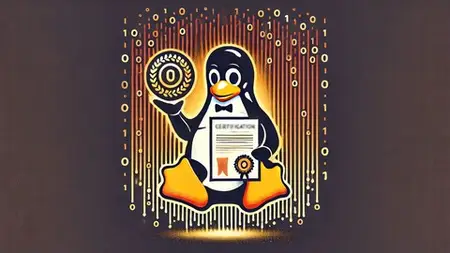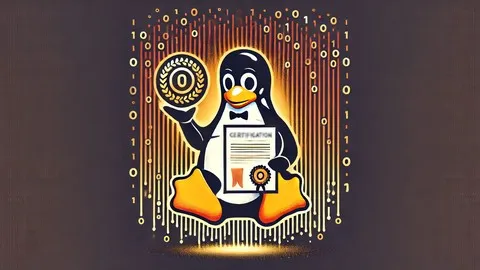Lpi Linux Essentials Certification Course And Practice Exams
Published 9/2024
MP4 | Video: h264, 1920x1080 | Audio: AAC, 44.1 KHz
Language: English | Size: 4.92 GB | Duration: 10h 39m
Published 9/2024
MP4 | Video: h264, 1920x1080 | Audio: AAC, 44.1 KHz
Language: English | Size: 4.92 GB | Duration: 10h 39m
Comprehensive Linux training with study guide and practice tests for the LPI Linux Essentials certification (010-160)
What you'll learn
Certification Success: Equip yourself with knowledge and strategies to confidently pass the LPI Linux Essentials Certification exam.
Linux Fundamentals: Explore the history of Linux, learn about major open-source applications, and understand software licensing models such as GPL and MIT.
Software Installation: Learn how to easily install, update, and manage software packages on Debian/Ubuntu and RedHat/Fedora systems.
Navigate and Manage Files: Get comfortable navigating the Linux file system and managing files and directories with essential command-line commands.
User and Group Management: Learn to set up Linux users and groups, including creating accounts, setting permissions, and configuring security settings.
Command-Line Proficiency: Harness command-line tools to search, extract data, and automate tasks through scripting.
Basic Networking and Security: Build a solid foundation in Linux networking concepts, hardware components, and system security practices.
Requirements
No Prior Linux Experience Needed: This course is designed for beginners, so no previous knowledge of Linux is required.
Description
Pass the LPI Linux Essentials Exam and Fast-Track Your IT Career!Unlock the door to a thriving IT career with this all-inclusive LPI Linux Essentials Certification Course. Designed for complete beginners, this course provides a solid foundation in Linux, preparing you to ace the LPI Linux Essentials Certification exam (010-160) on your first attempt.Why Choose Take This Course?Certification Success: Equip yourself with the knowledge and strategies to confidently pass the LPI Linux Essentials Certification exam.Hands-On Learning: Dive deep into Linux fundamentals with practical demonstrations on Debian/Ubuntu and RedHat/Fedora systems.Comprehensive Coverage: From understanding open-source software and licensing to mastering the command line, we've got you covered.Expert Instruction: Learn from an industry professional with decades of experience in Linux and open-source technologies.Career Advancement: Validate your skills and stand out in the competitive IT job market.What You'll Learn:Linux Fundamentals: Explore the history of Linux and its role in today's technology landscape.Software Installation: Master package management and software installation across different Linux distributions.File Management: Navigate the Linux file system and efficiently manage files and directories.User and Group Management: Set up and manage users, groups, and permissions to secure your system.Command-Line Proficiency: Harness powerful command-line tools to automate tasks and enhance productivity.Networking and Security: Build a solid foundation in networking concepts and learn essential security practices.Who Should Enroll?Aspiring IT Professionals: Kickstart your career by gaining essential Linux skills.Certification Seekers: Anyone aiming to obtain the LPI Linux Essentials Certification.Complete Beginners: No prior Linux experience needed—we start from the ground up.Career Changers: Transition into tech roles with confidence and validated skills.Tech Enthusiasts: Deepen your understanding of Linux and open-source applications.Take the Next StepLinux skills are in high demand. Whether you're starting your IT journey or looking to validate your expertise, this course is your gateway to success.Enroll Now and Become a Certified Linux Professional!
Overview
Section 1: The Linux Community and a Career in Open Source
Lecture 1 Intro to the Linux Evolution and Popular Operating Systems
Lecture 2 The Linux Kernel, Linux Operating Systems, and Linux Distributions
Lecture 3 RedHat-Based Linux Distributions
Lecture 4 Debian-Based Distros, Including Ubuntu
Lecture 5 Desktop vs Server Linux Distros (GUI vs CLI)
Lecture 6 Independent and Specialized Linux Distributions: Raspbian, SUSE, SLES, Android
Lecture 7 Embedded Systems Powered by Linux
Lecture 8 The Role of Linux in Cloud Computing
Lecture 9 Summary of the Linux Evolution and Popular Operating Systems
Lecture 10 Major Open Source Applications - Introduction
Lecture 11 Open Source Desktop Applications
Lecture 12 Open Source Server Applications
Lecture 13 Software Development Tools on Linux
Lecture 14 Installing Packages and Software on Linux
Lecture 15 Demonstration of Installing Software on Debian/Ubuntu Systems
Lecture 16 Demonstration of Installing Software on RedHat/Fedora Systems
Lecture 17 Major Open Source Applications - Summary
Lecture 18 Intro to Open Source Software and Licensing
Lecture 19 Free and Open Source Software: The Foundation of Linux
Lecture 20 Software Distribution Philosophies: Proprietary, Free, and Open Source
Lecture 21 Software Licensing Essentials: GPL, BSD, Creative Commons and More
Lecture 22 Open Source Business Models: Monetizing Free Software
Lecture 23 Summary of Open Source Software and Licensing
Lecture 24 Intro to ICT Skills and Working in Linux
Lecture 25 The Linux Desktop vs The Linux Command Line
Lecture 26 Linux Desktop Environments (Gnome, KDE, and Others)
Lecture 27 Terminals and Terminal Emulators
Lecture 28 Virtual TTYs
Lecture 29 Common Software and Industry Use Cases for Linux Including Cloud Computing
Lecture 30 Privacy and Security
Lecture 31 Encryption Techniques Employed on Linux
Lecture 32 Summary of ICT Skills and Working in Linux
Section 2: Finding Your Way on a Linux System
Lecture 33 Intro to Command Line Basics
Lecture 34 Linux Shell Basics and the Command Line Prompt
Lecture 35 Basic / Essential Linux Commands
Lecture 36 Exercise (Optional)
Lecture 37 Linux Command Options and Arguments
Lecture 38 Shell Variables and Environment Variables
Lecture 39 Special Characters, Wildcards, Quoting, and Escaping on the Linux Command Line
Lecture 40 Internal and External Linux Commands
Lecture 41 Summary of Command Line Basics
Lecture 42 Intro to Using the Command Line to Get Help
Lecture 43 Common Ways to Get Help on Linux Command Line
Lecture 44 Demonstration of the Man Command
Lecture 45 Demonstration of the Info Command
Lecture 46 Demonstration of the /usr/share/doc Directory
Lecture 47 Demonstration of the -h and –help Command Options
Lecture 48 Demonstration of a Search Engine for Linux Help
Lecture 49 Summary of Using the Command Line to Get Help
Lecture 50 The find and locate Commands
Lecture 51 Intro to Using Directories and Listing Files
Lecture 52 Linux File and Directory Basics
Lecture 53 Creating and Naming Files and Directories On Linux
Lecture 54 The Hierarchical Structure of Linux Directories
Lecture 55 Understanding the Linux Current Working Directory
Lecture 56 Absolute and Relative Paths
Lecture 57 Linux Directory Shortcuts Demo
Lecture 58 Essential Linux Directories and the FHS
Lecture 59 The Linux ls Command and Options
Lecture 60 Recursion in Bash
Lecture 61 Summary of Using Directories and Listing Files
Lecture 62 Intro to Creating, Moving and Deleting Files
Lecture 63 Understanding Files and Directories
Lecture 64 Creating Directories and Viewing Directory Hierarchies
Lecture 65 Creating Files Using the touch and echo Commands
Lecture 66 Viewing the Contents of Files Using the cat, more, and less Commands
Lecture 67 Copying Files and Directories with the cp Command
Lecture 68 Moving and Renaming Files and Directories with the mv Command
Lecture 69 Deleting Files and Directories using the rm and rmdir Commands
Lecture 70 Globbing: Using Wildcards and Regular Expressions
Lecture 71 Summary of Creating, Moving and Deleting Files
Section 3: The Power of the Command Line
Lecture 72 Intro to Archiving Files on the Linux Command Line
Lecture 73 Introduction to the Tar Command
Lecture 74 Creating Tar Archives
Lecture 75 Using tar with Absolute Paths
Lecture 76 Displaying the Contents of a tar Archive
Lecture 77 Extracting Data from Tarballs
Lecture 78 File Compression Basics: Algorithms, Ratios, and Lossless/Lossy Compression
Lecture 79 Common Compression Utilities and Tools
Lecture 80 Using Compression with the tar Command
Lecture 81 Zip and Creating Windows-Compatible Archives
Lecture 82 Summary of Archiving Files on the Linux Command Line
Lecture 83 Searching and Extracting Data from Files
Lecture 84 Turning Commands into a Script
Section 4: The Linux Operating System
Lecture 85 Intro to Choosing an Operating System
Lecture 86 Operating System Selection Criteria
Lecture 87 Major Operating Systems
Lecture 88 Linux Distribution Lifecycles
Lecture 89 Linux Distribution Types and Purposes
Lecture 90 Choosing an Operating System - Summary
Lecture 91 Intro to Understanding Computer Hardware
Lecture 92 Power Supplies and Cooling
Lecture 93 Memory
Lecture 94 Processors
Lecture 95 Storage
Lecture 96 Devices and Peripherals
Lecture 97 Summary of Understanding Computer Hardware
Lecture 98 Where Data is Stored
Lecture 99 Understanding Computer Hardware
Lecture 100 Intro to Your Computer on the Network
Lecture 101 The OSI and TCP/IP Network Models
Lecture 102 Layers of the TCP/IP Model
Lecture 103 Packet Switching
Lecture 104 Domain Name System (DNS)
Lecture 105 The ping Command
Lecture 106 The Link Layer of the OSI Model
Lecture 107 The IPv4 Protocol
Lecture 108 Subnets and Network Address Translation (NAT)
Lecture 109 IPv4 Routing and Allocating IP Addresses
Lecture 110 The IPv6 Protocol
Lecture 111 Network Sockets
Lecture 112 Summary of Your Computer on the Network
Lecture 113 Intro to Basic Security and Identifying User Types
Lecture 114 Linux Account Types: Superuser, System, Service, and Standard Users
Lecture 115 Linux User Groups
Lecture 116 User Account Properties: Login Shells, Home Directories, and Primary Groups
Lecture 117 Displaying User Information, id, who, w, last, lastb Commands
Lecture 118 Acquiring Superuser Privileges: su, sudo, and visudo Explained
Lecture 119 User Configuration Files in Linux
Lecture 120 Summary of Basic Security and Identifying User Types
Lecture 121 Intro to Creating Linux Users and Groups
Lecture 122 Linux User and Group Configuration Files
Lecture 123 Managing Linux User Accounts
Lecture 124 Configuring Default Linux User Settings
Lecture 125 Managing Linux Groups
Lecture 126 Summary of Creating Users and Groups
Lecture 127 Intro to Managing File Permissions and Ownership
Lecture 128 Viewing File and Directory Permissions with the ls Command
Lecture 129 Understanding Linux File and Directory Permissions
Lecture 130 Modifying File and Directory Permissions on Linux
Lecture 131 Summary of Modifying File and Directory Permissions on Linux
Lecture 132 Managing File and Directory Ownership on Linux
Lecture 133 Special Permissions: SUID, SGID, and the Sticky Bit
Lecture 134 Summary of Managing File Permissions and Ownership
Lecture 135 Intro to Special Directories and Files
Lecture 136 Temporary Files and Directories
Lecture 137 Creating and Managing Hard Links
Lecture 138 Creating and Managing Symbolic Links
Lecture 139 Summary of Special Directories and Files
Section 5: Practice Exams
Anyone looking to obtain the LPI Linux Essentials Certification.,Aspiring IT Professionals: Individuals wanting to start a career in IT and looking to validate their Linux knowledge with the LPI Linux Essentials Certification.,Complete Linux Beginners: People with little to no prior experience with Linux who want a structured, step-by-step guide to understanding Linux fundamentals.,Career Changers: Individuals from non-technical backgrounds aiming to gain essential Linux skills to transition into technology roles.



